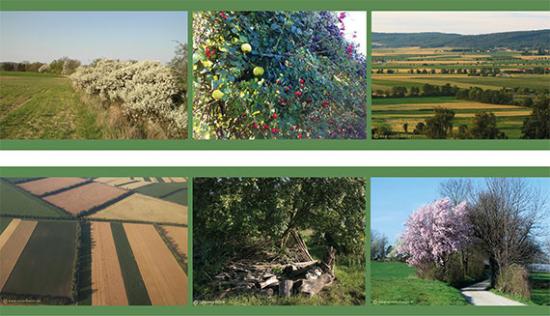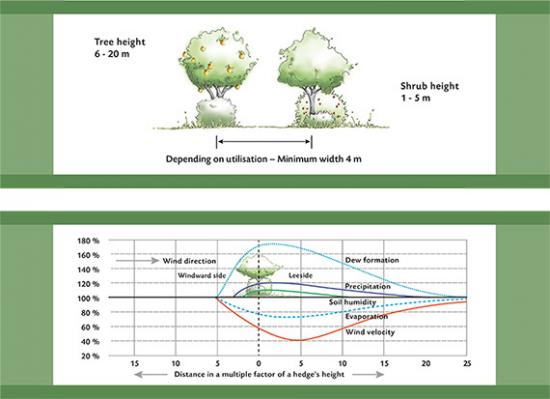Lassee Edible Landscape
MULTIFUNCTIONAL HEDGES
Hedges are actually two forest edges without the forest in between them. These fringe zones are home to life at its most intense and productive. Here you can find a blend of the habitats of several species of flora and fauna belonging to different biotopes. Hedges are also important corridors for deer crossing, they are home to a vast number of small animals, birds and insects.
As windbreakers they counteract soil erosion and wind induced soil dehydration.

The multifunctional hedge combines local wild shrubs with fruit and nut cultivars. In its double row configuration, it constitutes an avenue accessible by vehicle, thus creating biotopes with different degrees of shade and sunlight. Introducing deadwood or pruning of the hedge creates additional habitats for insects.

In order to maintain a hedge as a natural habitat, portions of the hedge have to be pruned at regular intervals of several years. This involves radical trimming of the wild shrubs to almost ground level in order to prevent the hedge from becoming a tree row. Fruit shrubs and trees are not pruned quite as vigorously.
The protective action of a hedge ranges up to 30 times the height of the enclosure (5 times in front of and 25 times behind the hedge.) A hedge of 10 m height therefore would provide a protective area of up to 300 m with an optimum protection of 200 m. The maximum protective action is behind the hedge at 5 times the height of the hedge. At a height of 10 m, therefore, this would amount to 50 m. Hedges planted transversely on slopes also reduce water induced erosion caused by heavy rain.
The hedge border is ideally adjacent to a fringe zone made up of wild herbs and perennials. This forms the transition to the meadow or field and constitutes a separate biotope for insects.
Maximum protection is given behind the hedge!

04.11.2025
EUSDR PA10: 12th Danube Participation Day in Sarajevo
mehr ...30.10.2025
Online-Präsentation BBK-Projekt CNSoil - Zwischenergebnisse
mehr ...07.10.2025
CatchHedge - Potenziale von Hecken im Zeichen des Klimawandels
mehr ...16.+17.09.2025
32nd Conference of the Danube Region
mehr ...12.09.2025
Grundlagen der professionellen Bio-Mandel-Produktion
mehr ...10.09.2025
Agroforst u. Marktgärtnerei, Symbiose
mehr ...05.09.2025
Regionales Wiesensaatgut gewinnen mit dem Wiesensamenernter
mehr ...25.06.2025
Feldtag - StripTill im Bio-Mais im Trockengebiet
mehr ...25.06.2025
Seminar: Wildbienen- und Nützlingsförderung im Biolandbau
mehr ...24.06.2025
BOKU Green Plate Forum 3.0
mehr ...24.06.2025
Die Maulbeere - Kultur, Produktion u.Verwendung
mehr ...17.06.2025
Frühjahrstagung Österr. Gesellschaft für Agrar- und Umweltrecht (ÖGAUR)
mehr ...13.06.2025
Seminar: Artenvielfalt in Ackerbauregionen fördern
mehr ...03.06.2025
Seminar: Keine Angst vor der Ackerdistel
mehr ...03.06.2025
Agroforstsysteme: Anbau-Modelle der Zukunft
mehr ...20.05.2025
IDM-Generalversammlung 2025
mehr ...15.05.2025
Seminar: Unkräuter/Beikräuter erkennen und als Zeigerpflanzen nutzen
mehr ...13.+14.05.2025
Bodenforum Österreich - Frühjahrstreffen
mehr ...04.05.2025
Tageskurs: Perma-Veggies - Mehrjähriges Gemüse und essbare Stauden
mehr ...03.05.2025
Waldgärten-Exkursion
mehr ...


